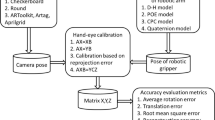Abstract
We describe a method to solve the stereo correspondence using controlled head (or camera) movements. These movements, which can be due to eye rotation, head rotation, or head translation, essentially supply additional imageframes which can be used to constrain the stereo matching by supplying monocular cues. Because the movements are small, traditional methods of stereo with multiple frame will not work. We develop an alternative approach using a systematic analysis to define a probability distribution for the errors. Our matching strategy then matches the most probable points first (based on the monocular cues), thereby reducing the ambiguity for the remaining matches. We demonstrate this algorithm in detail for the cases of head and eye rotation and illustrate it with some examples.
Similar content being viewed by others
References
T. Barnard and M.A. Fischler, “Computational stereo”. Computing Surveys, 14, 1982.
J.F. Canny, “Finding lines and edges in images”, Tech. Rept. TM-720, Artifical Intelligence Laboratory, Massachusetts Institute of Technology, 1983.
K.H. Cornog, “Smooth pursuit and fixation for robot vision”, Master's thesis, Massachusetts Institute of Technology, 1985.
D. Geiger and A. Yuille, “Stereo and eye movement”, Biological Cybernetics, 1989.
N.M. Grzywacz and A. Yuille, “Motion correspondence and analog networks”. A.I. Memo No. 888, Artificial Intelligence Laboratory, Massachusetts Institute of Technology, 1986.
E.C. Hildreth, The Measurement of Visual Motion, MIT Press, Cambridge, MA., 1984.
J.D. Krol and W.A.Van der Grind, “The double-nail illusion: Experiments on binocular vision with nails, needles and pins”, Perception, 11:615–619, 1982.
H.C. Longuet-Higgins, “The role of the vertical dimension in stereoscopic vision”, Perception, 11:377–386, 1982.
D. Marr and S. Ullman, “Directional selectivity and its use in early visual processing”, Proc. Roy. Soc. London B, 211:151–180, 1981.
V.J. Milenkovic and T. Kanade, “Trinocular vision using photometric and edge orientation constraints”, Proc. Image Understanding Workshop, pp. 163–175, Miami, 1986.
K. Prazdny, “Detection of binocular disparities”, Biological Cybernetics, 52:93–99, 1985.
S. Ullman, The Interpretation of Visual Motion. MIT Press, Cambridge and London, 1979.
A.M. Waxman and J.J. Duncan. “Binocular image flows”, Proc. Workshop on Motion: Representation and Analysis, pp. 31–38, Kiawah Island, S.C., 1986.
Author information
Authors and Affiliations
Additional information
MIT Artificial Intelligence Laboratory
Rights and permissions
About this article
Cite this article
Yuille, A., Geiger, D. Stereo and controlled movement. Int J Comput Vision 4, 141–152 (1990). https://doi.org/10.1007/BF00127814
Issue Date:
DOI: https://doi.org/10.1007/BF00127814




